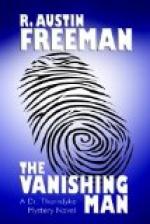“Then you think that the person who dismembered this body must have had some anatomical knowledge and skill?”
“That is what has been suggested. The suggestion is not mine.”
“Then I infer that you don’t agree?”
Thorndyke smiled. “I am sorry to be so cryptic, Berkeley, but you understand that I can’t make statements. Still, I am trying to lead you to make certain inferences from the facts that are in your possession.”
“If I make the right inference, will you tell me?” I asked.
“It won’t be necessary,” he answered, with the same quiet smile. “When you have fitted a puzzle together you don’t need to be told that you have done it.”
It was most infernally tantalising. I pondered on the problem with a scowl of such intense cogitation that Thorndyke laughed outright.
“It seems to me,” I said, at length, “that the identity of the remains is the primary question and that is a question of fact. It doesn’t seem any use to speculate about it.”
“Exactly. Either these bones are the remains of John Bellingham or they are not. There will be no doubt on the subject when all the bones are assembled—if ever they are. And the settlement of that question will probably throw light on the further question: Who deposited them in the places in which they were found? But to return to your observations: did you gather nothing from the other bones? From the complete state of the neck vertebrae, for instance?”
“Well, it did strike me as rather odd that the fellow should have gone to the trouble of separating the atlas from the skull. He must have been pretty handy with the scalpel to have done it as cleanly as he seems to have done; but I don’t see why he should have gone about the business in the most inconvenient way.”
“You notice the uniformity of method. He has separated the head from the spine, instead of cutting through the spine lower down, as most persons would have done: he removed the arms with the entire shoulder-girdle, instead of simply cutting them off at the shoulder-joints. Even in the thighs the same peculiarity appears; for in neither case was the knee-cap found with the thigh-bone, although it seems to have been searched for. Now the obvious way to divide the leg is to cut through the patellar ligament, leaving the knee-cap attached to the thigh. But in this case, the knee-cap appears to have been left attached to the shank. Can you explain why this person should have adopted this unusual and rather inconvenient method? Can you suggest a motive for this procedure, or can you think of any circumstances which might lead a person to adopt this method by preference?”




